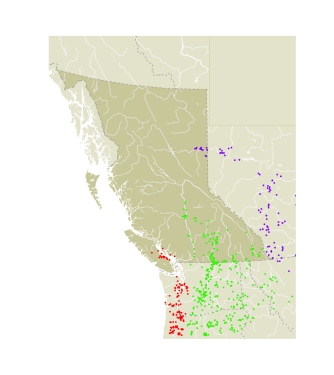The name Cercyonis is derived from Cercyon, the son of Poseidon (Opler and Krizek 1984). The common name "woodnymphs" was first used by Holland (1898) in reference to the butterflies' bouncy flight in generally open forest habitat, similar to nymphs bounding through open forests.
Woodnymphs are medium-sized, dark brown butterflies with prominent eyespots on the forewings and sometimes smaller eyespots on the hindwings. The eyespots are usually larger in females than in males, and are set in a lighter band. Woodnymphs have a peculiar bouncing flight, similar to that of ringlets.
Eggs are laid singly on grass blades. They are pale yellow, becoming tan and mottled with orange brown as they mature. They are cylindrical and squat, with a flat top and ridges down the side. First instar larvae are thinly covered with thick curved hairs, and are green with light and dark longitudinal stripes. Mature larvae are slender, green, or yellow green, with light and dark longitudinal stripes down the back and sides. They are thinly covered with hairs, and have two short red tails. Pupae are roughly cylindrical, rounded, and suspended from a cremaster. They are green to yellow green, and in most species have white or yellow markings (Emmel 1969).
Eggs hatch about 10 days after oviposition (at 25°C), and the first instar larvae immediately enter hibernation. By spring the larvae have shrunk to half their original length before they come out of hibernation. Once they commence feeding, they primarily feed at night. There are five (oetus, sthenele) or six (pegala) larval instars. It takes oetus about 2 months to pupate in the wild, and sthenele and pegala 2.5-3 months. Pupation occurs near the base of a grass clump, with the pupa hanging from grass blades. Adults emerge after about 20 days (EmmeI 1969).
|
|
